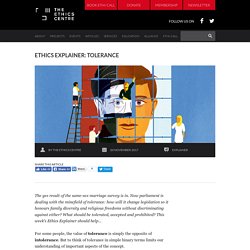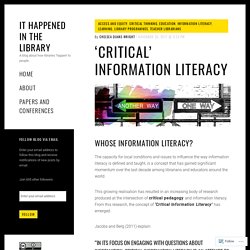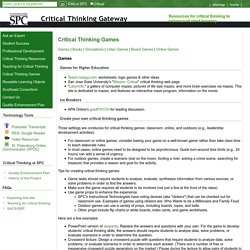

SLAV - Question Generator. How to Find Better Information Online: Click Restraint. How to Use Wikipedia Wisely. Sort Fact from Fiction Online with Lateral Reading. Videos. Sorting Truth From Fiction - A discussion board for the Teaching Systems Lab EdX Course occurring Fall 20020. Intro to What Do Other Sources Say? Saturday School. How to Find Better Information Online: Click Restraint. Civic Online Reasoning. All About Asking Better Questions. Asking questions is such a basic tool of teaching, yet how many of us have ever been taught to ask good questions?

As I started researching for this post, I realized how little I actually knew about asking questions. I asked hundreds of questions a day but had zero training. I know I’m not alone! Here’s the plan: So, we’ll actually start in perhaps a strange place, which is to open with the idea of asking fewer questions as teachers and allowing more room for students to be the questioners. Mrs. Let me take you back to 1997, when my sophomore English teacher, Mrs. Why would a teacher have such a hard time getting her advanced 10th graders to ask a darn question?
Well, as one of those students, I can tell you that I had been trained to answer questions, not ask them. I pledged to ask two questions and doubt I lived up to my bargain. Who Asks Whom? So, as we dig into questioning, let’s start with wondering who asks the questions in your classroom and who gets asked. How to Raise Media-Savvy Kids in the Digital Age. How to Spot Bullshit: A Primer by Princeton Philosopher Harry Frankfurt. We live in an age of truthiness.

Comedian Stephen Colbert coined the word to describe the Bush administration’s tendency to fudge the facts in its favor. Ten years after the American Dialect Society named it Word of the Year, former president Bush’s calendar is packed with such leisure activities as golf and painting portraits of world leaders, but "truthiness" remains on active duty. It’s particularly germane in this election year, though politicians are far from its only practitioners. Take global warming.
NASA makes a pretty rock solid case for both its existence and our role in it: 97 percent or more of actively publishing climate scientists agree: Climate-warming trends over the past century are extremely likely due to human activities. In view of such numbers, its understandable that a suburban Joe with a freezer full of factory-farmed beef and multiple SUVs in his garage would cling to the position that global warming is a lie. But such self-rationalizations are not truth.
Framework for Information Literacy for Higher Education. Filed by the ACRL Board on February 2, 2015.

Adopted by the ACRL Board, January 11, 2016. This work is licensed under a Creative Commons Attribution-NonCommercial-ShareAlike 4.0 International License. Journaling as a means to scaffold & assess learning. Journaling is like whispering to one’s self and listening at the same time.Mina Murray In an earlier post, I discussed formative and summative assessments, and how they can provide opportunities to support learners.

Assessment is a fundamental component of the teaching & learning process. Formative & summative assessments can provide meaningful opportunities to meet the diverse needs of students. Inquiry-Based Learning Tools for Teachers. Queensland Curriculum and Assessment Authority. Navigating the Information Landscape: Resources for Young People.
As librarians, we are continually challenged and tasked with creating programming that teach multiple literacies — including information literacy, digital literacy, news literacy and media literacy — in fun, engaging and interactive ways.

School librarians are in a special position to provide resources to both students and teachers about various kinds of literacy, including digital, news and media. As we move to the midway point in our school year, we thought it might be a good idea to revisit why teaching multiple literacies is important. We also thought it would be a good idea to share some sites where you can find great programming to engage students and teachers. Skills for information consumers By the time students leave our schools for the workforce, colleges and careers, we want them to be thoughtful researchers and critical consumers of information. The list of skills mentioned above is just the tip of the iceberg. Resources for the classroom and library.
6 Questions Every Critical Thinker Should Ask. Games for Building Critical Thinking Skills. 50 Questions To Help Students Think About What They Think - TeachThought. Contributed by Lisa Chesser Using the right questions creates powerful, sometimes multiple answers and discussions.

Aristotle said that he asked questions in response to other people’s views, while Socrates focused on disciplined questioning to get to the truth of the matter. Ultimately questions spark imagination, conjure emotions, and create more questions. The questions asked by a teacher or professor are sometimes more glaringly valuable than the information transferred to the students.
Those questions spark a thought, which leads to a fiercely independent search for information. If students are the ones gathering that information then they’re the ones learning it and student-driven learning cements lessons into the students’ minds making any lesson more powerful with this strategy. The questions are unrestricted and open the mind up to unfettered thought, perfect for innovation and understanding. Many, Many Examples Of Essential Questions. Many, Many Examples Of Essential Questions by Terry Heick Essential questions are, as Grant Wiggins defined, ‘essential’ in the sense of signaling genuine, important and necessarily-ongoing inquiries.” These are grapple-worthy, substantive questions that not only require wrestling with, but are worth wrestling with–that could lead students to some critical insight in a 40/40/40-rule sense of the term. I collected the following set of questions through the course of creating units of study, most of them from the Greece Central School District in New York.
In revisiting them recently, I noticed that quite a few of them were closed/yes or no questions, so I went back and revised some of them, and added a few new ones, something I’ll try to do from time to time. Ww2.kqed. [Module C] Critical thinking. Teaching Critical Thinking - Full Video. Home Page. The Ethics Centre - Ethics Explainer: Tolerance. The yes result of the same-sex marriage survey is in.

Now parliament is dealing with the minefield of tolerance: how will it change legislation so it honours family diversity and religious freedoms without discriminating against either? What should be tolerated, accepted and prohibited? This week’s Ethics Explainer should help… For some people, the value of tolerance is simply the opposite of intolerance. ‘Critical’ Information Literacy. The capacity for local conditions and issues to influence the way information literacy is defined and taught, is a concept that has gained significant momentum over the last decade among librarians and educators around the world.

This growing realisation has resulted in an increasing body of research produced at the intersection of critical pedagogy and information literacy. From this research, the concept of ‘Critical Information Literacy’ has emerged. Jacobs and Berg (2011) explain: Taxonomy of the Logical Fallacies. St. Petersburg College Critical Thinking Gateway. Three settings are conducive for critical thinking games: classroom, online, and outdoors (e.g., leadership development activities): Simulations provide realistic or semi-realistic opportunities for students to practice skills and solve problems in safe environments.

They differ from structured experiential activities by their multi-part and branching nature. A typical simulation will provide an opening scenario that requires students to engage in a planning activity. In a second round, the student or group must use the skills or theories from the course to make a decision regarding a significant problem. Then, depending on the individual’s or group’s decision, the simulation will provide results from that decision that will drive subsequent decisions. Critical thinking On The Web. Top Ten Argument Mapping Tutorials.

Six online tutorials in argument mapping, a core requirement for advanced critical thinking.The Skeptic's Dictionary - over 400 definitions and essays. The Fallacy Files by Gary Curtis. Best website on fallacies. Butterflies and Wheels. Learn the Elements and Standards. Critical Thinking: Where to Begin. Critical Thinking Model 1. To Analyze Thinking We Must Identify and Question its Elemental Structures Standard: Clarityunderstandable, the meaning can be grasped Could you elaborate further?
Could you give me an example? Could you illustrate what you mean? Standard: Accuracyfree from errors or distortions, true. Thinking about Thinking: The Power of Noticing. According to Einstein, “Education is not the learning of facts, but the training of the mind to think.” I completely agree that learning to think should be one of the essential goals of education, but as I wrote in an earlier post, many of the tasks we set for kids and the scaffolds we teach them to use don’t really seem aimed at fostering thinking as much as completing those tasks. In that post, I offered an example of what a lesson focused on actual thinking might look like. And here, I’d like to take a deeper look at what we really mean by thinking and how we actually do it.
One of the most common definitions you’ll find online is that “Thinking is a purposeful organized cognitive process that we use to make sense of our world.” That isn’t bad as definitions go, but it doesn’t offer any clues about how to think or what that process entails.
Critical Thinking Across the Curriculum. Jillian Turner, Big History Teacher Sydney, Australia The chief aim of any teacher is to equip our students to think. In an age of “fake news” and conflicting truths, the significance of logical, reasoned argument and critical thinking is painfully apparent. We can often, however, find that a crowded curriculum worries out these loftier aims. The pressure to ensure our students cover the content for each topic in order to pass an exam can be more immediate than any long-term gains.
Educational Leadership:Writing: A Core Skill:Argument Writing Across the Content Areas. Educational Leadership:Literacy in Every Classroom:Why Argue? How do you know that what you know is true? That's epistemology. How do you know what the weather will be like tomorrow? How do you know how old the Universe is? How do you know if you are thinking rationally? These and other questions of the “how do you know?” Variety are the business of epistemology, the area of philosophy concerned with understanding the nature of knowledge and belief. Epistemology is about understanding how we come to know that something is the case, whether it be a matter of fact such as “the Earth is warming” or a matter of value such as “people should not just be treated as means to particular ends”.
It’s even about interrogating the odd presidential tweet to determine its credibility. Critical Thinking Cheatsheet for Teachers. 5 tips to improve your critical thinking - Samantha Agoos. 28 Critical Thinking Question Stems For Any Content Area - 35 Psychology-Based Learning Strategies For Deeper Learning. The Big List of Class Discussion Strategies. Bloom's Digital Taxonomy Verbs [Infographic] 3 Simple Strategies to Develop Students’ Critical Thinking – Education to Save the World. This week we’ve focused on critical thinking using the model developed by the Foundation for Critical Thinking.
By now you’re probably excited about the incredible potential that these tools hold…and a little overwhelmed. Overcoming Obstacles to Critical Thinking. The ability to think critically is one skill separating innovators from followers. It combats the power of advertisers, unmasks the unscrupulous and pretentious, and exposes unsupported arguments. Students enjoy learning the skill because they immediately see how it gives them more control. Edutopia. Editor's note: This post is co-authored by Nancy Frey, a Professor of Literacy in Educational Leadership at San Diego State University and a credentialed special educator, reading specialist, and administrator. 10 Team-Building Games That Promote Critical Thinking. Critical Thinking Part 6: A Precautionary Tale. Critical Thinking Part 5: The Gambler's Fallacy. Critical Thinking Part 3: The Man Who Was Made of Straw.
Critical Thinking Part 2: Broken Logic. Critical Thinking Part 1: A Valuable Argument. 32 Animated Videos by Wireless Philosophy Teach You the Essentials of Critical Thinking. Oxford's Free Course Critical Reasoning For Beginners Will Teach You to Think Like a Philosopher. The Questioning Toolkit - Revised. 32 Animated Videos by Wireless Philosophy Teach You the Essentials of Critical Thinking. Two Puzzles to Stretch Students’ Logical Thinking.
Oxford's Free Course Critical Reasoning For Beginners Will Teach You to Think Like a Philosopher. The Critical Thinking Skills Cheatsheet [Infographic] 32 Animated Videos by Wireless Philosophy Teach You the Essentials of Critical Thinking. Ultimate Critical Thinking Cheat Sheet. #TEDEdChat: The surprising habits of original thinkers. Happy Birthday, Descartes: 12 “Rules for the Direction of the Mind” from the Founding Father of Western Philosophy. Fake News: Not Your Main Problem. The Daily Mixer. Educator Resources. Visible Thinking. HOTandThinkertools - home.
Resources and Downloads for Teaching Critical Thinking. Narrable. 4 Great Web-Based Mindmapping Tools To Enhance Your Creativity. Ten Good Online Tools for Creating Mind Maps. Home. The 10 Stages of the Creative Process. Fallacies. Fallacies Thou shalt not commit logical fallacies. Critical thinking activity game for high,middle school,college students,problem solving skills games Shift 2 for kids,adults. Operation ARIES! Exploratree - Exploratree by FutureLab. Bloom’s Taxonomy. Toulmin Model. Untitled 1. Instructional Design The Taxonomy Table. Developing Questions for Critical Thinking.
Bloom's Digital Taxonomy. More Critical Thinking Videos. How to Make a Mind Map: 11 Steps. How to teach mind mapping and how to make a mind map. High School Teachers. Critical-thinking - home. Geniushour - Resources. Questioning – Top Ten Strategies. A Quick Guide to 21st Century Critical Thinking Skills for Educators. Online Mind Mapping and Brainstorming app - SpiderScribe. Popplet. Six Vintage-Inspired Animations on Critical Thinking.